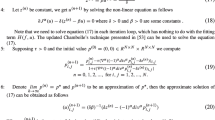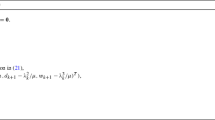Abstract
Image inpainting and denoising are two important preprocessing steps widely used in image and visual analysis. In this paper, by the maximum a posterior estimation, we present a new framework to remove multiplicative noise and artifacts simultaneously, when the locations of the artifacts/damaged pixels are unknown. By taking into account the statistical distribution of multiplicative noise as Gamma or Rayleigh noise, we give the special data fidelity term. To suppress the noise and repair the missing intensities, the proposed method applies spatial regularization to the desirable image, and \(\ell _{0}\) norm regularization to the artifacts. We introduce three typical spatial regularization: total variation, second-order total generalized variation (TGV) and fractional-order total variation (FOTV) for smoothing images. Due to the non-convexity and non-differentiability of the proposed minimization problem, we introduce additional auxiliary variables to simplify the original problem, and then use the alternating direction method of multipliers to solve it. A set of experiments on synthetic images and real medical ultrasound images show that the proposed method can efficiently remove the multiplicative noise, and more importantly fill in the missing pixels very well. Compared to other similar method, the TGV and FOTV regularization can not only preserve edges and texture details of the image but also avoid the staircase effect.










Similar content being viewed by others
References
Lee, J.: Digital image enhancement and noise filtering by use of local statistics. IEEE Trans. Pattern Anal. Mach. Intell. PAMI-2(2), 165–168 (1980). https://doi.org/10.1109/TPAMI.1980.4766994
Frost, V., Stiles, J., Shanmugan, K., Holtzman, J.: A model for radar images and its application to adaptive digital filtering of multiplicative noise. IEEE Trans. Pattern Anal. Mach. Intell. PAMI-4, 157–166 (1982). https://doi.org/10.1109/TPAMI.1982.4767223
Kuan, D., Sawchuk, A., Strand, T., Chavel, P.: Adaptive noise smoothing filter for images with signal-dependent noise. IEEE Trans. Pattern Anal. Mach. Intell. 7, 165–177 (1985). https://doi.org/10.1109/TPAMI.1985.4767641
Loupas, T., McDicken, W., Allan, P.: An adaptive weighted median filter for speckle suppression in medical ultrasonic images. IEEE Trans. Circuits Syst. 36, 129–135 (1989). https://doi.org/10.1109/31.16577
Coupé, P., Hellier, P., Kervrann, C., Barillot, C.: Nonlocal means-based speckle filtering for ultrasound images. IEEE Trans. Image Process. 18, 2221–2229 (2009). https://doi.org/10.1109/TIP.2009.2024064
Deledalle, C., Denis, L., Tupin, F.: Iterative weighted maximum likelihood denoising with probabilistic patch-based weights. IEEE Trans. Image Process. 18, 2661–2672 (2010). https://doi.org/10.1109/TIP.2009.2029593
Aubert, G., Aujol, J.F.: A variational approach to removing multiplicative noise. SIAM J. Appl. Math. 68, 925–946 (2008). https://doi.org/10.1137/060671814
Shi, J., Osher, S.: A nonlinear inverse scale space method for a convex multiplicative noise model. SIAM J. Imaging Sci. 1, 294–321 (2008). https://doi.org/10.1137/070689954
Wen, Y.W., Ng, M., Wen, Y.W.: A new total variation method for multiplicative noise removal. SIAM J. Imaging Sci. 2, 20–40 (2009). https://doi.org/10.1137/080712593
Rudin, L., Lions, P., Osher, S.: Multiplicative denoising and deblurring: Theory and algorithms. Geom. Level Set Methods Imaging Vis. Graphics 4, 103–120 (2003). https://doi.org/10.1007/0-387-21810-6_6
Steidl, G., Teuber, T.: Removing multiplicative noise by Douglas–Rachford splitting methods. J. Math. Imaging Vis. 36, 168–184 (2010). https://doi.org/10.1007/s10851-009-0179-5
Shen, C., Pi, L., Peng, Y., Li, Z.: Variational-based speckle noise removal of SAR imagery. In: 2007 IEEE International Geoscience and Remote Sensing Symposium, pp. 532–535 (2007). https://doi.org/10.1109/IGARSS.2007.4422848
Li, F., Ng, M., Shen, C.: Multiplicative noise removal with spatially varying regularization parameters. SIAM J. Imaging Sci. 3, 1–20 (2010). https://doi.org/10.1137/090748421
Seabra, J., Xavier, J.a., Sanches, J.a.: Convex ultrasound image reconstruction with Log–Euclidean priors. In: 2008 30th Annual International Conference of the IEEE Engineering in Medicine and Biology Society 2008, 435–438 (2008). https://doi.org/10.1109/IEMBS.2008.4649183
Lu, J., Yang, Z., Shen, L., Lu, Z., Yang, H., Xu, C.: A framelet algorithm for de-blurring images corrupted by multiplicative noise. Appl. Math. Model. 62, 51–61 (2018). https://doi.org/10.1016/j.apm.2018.05.007
Li, C., Ren, Z., Tang, L.: Multiplicative noise removal via using nonconvex regularizers based on total variation and wavelet frame. J. Comput. Appl. Math. 370, 112684 (2019). https://doi.org/10.1016/j.cam.2019.112684
Dong, F., Zhang, H., Kong, D.X.: Nonlocal total variation models for multiplicative noise removal using split Bregman iteration. Math. Comput. Model. 55, 939–954 (2012). https://doi.org/10.1016/j.mcm.2011.09.021
Liu, P.: Hybrid higher-order total variation model for multiplicative noise removal. IET Image Process. 14(5), 862–873 (2020). https://doi.org/10.1049/iet-ipr.2018.5930
Shama, M., Huang, T., Liu, J., Wang, S.: A convex total generalized variation regularized model for multiplicative noise and blur removal. Appl. Math. Comput. 276, 109–121 (2016). https://doi.org/10.1016/j.amc.2015.12.005
Tian, D., Du, Y., Chen, D.: An adaptive fractional-order variation method for multiplicative noise removal. J. Inf. Sci. Eng. 32, 747–762 (2016)
Chen, G., Li, G., Liu, Y., Zhang, X.P., Zhang, L.: Sar image despeckling based on combination of fractional-order total variation and nonlocal low rank regularization. IEEE Trans. Geosci. Remote Sens. 58, 483–491 (2020)
Gao, Y., Yang, X.: Tgv-based multiplicative noise removal approach: Models and algorithms. J. Inverse Ill-posed Probl. 26, 703–727 (2018). https://doi.org/10.1515/jiip-2016-0051
Bredies, K., Kunisch, K., Pock, T.: Total generalized variation. SIAM J. Imaging Sci. 3, 492–526 (2010). https://doi.org/10.1137/090769521
Na, H., Kang, M., Jung, M., Kang, M.: Nonconvex tgv regularization model for multiplicative noise removal with spatially varying parameters. Inverse Probl. Imaging 13, 117–147 (2019). https://doi.org/10.3934/ipi.2019007
Milici, C., Draganescu, G., Tenreiro Machado, J.: Fractional Differential Equations, pp. 47–86 (2019). https://doi.org/10.1007/978-3-030-00895-6_4
Barcelos, C., Batista, M.: Image restoration using digital inpainting and noise removal. Image Vis. Comput. 25, 61–69 (2007). https://doi.org/10.1016/j.imavis.2005.12.008
Rodríguez, P., Rojas, R., Wohlberg, B.: Mixed gaussian-impulse noise image restoration via total variation. In: 2012 IEEE International Conference on Acoustics, Speech and Signal Processing (ICASSP), pp. 1077–1080 (2012). https://doi.org/10.1109/ICASSP.2012.6288073
Thai, D., Gottschlich, C.: Simultaneous inpainting and denoising by directional global three-part decomposition: connecting variational and fourier domain based image processing. R. Soc. Open Sci. 5, 171–176 (2016). https://doi.org/10.1098/rsos.171176
Dong, B., Ji, H., Li, J., Shen, Z., Xu, Y.: Wavelet frame based blind image inpainting. Appl. Comput. Harmon. Anal. 32, 268–279 (2012). https://doi.org/10.1016/j.acha.2011.06.001
Yang, J.: A tv-based approach to blind image inpainting. In: 2011 4th International Congress on Image and Signal Processing 2, 779–781 (2011). https://doi.org/10.1109/CISP.2011.6100364
Yan, M.: Restoration of images corrupted by impulse noise and mixed gaussian impulse noise using blind inpainting. SIAM J. Imaging Sci. 6, 1227–1245 (2013). https://doi.org/10.1137/12087178X
Wang, Y., Szlam, A., Lerman, G.: Robust locally linear analysis with applications to image denoising and blind inpainting. SIAM J. Imaging Sci. 6, 526–562 (2013). https://doi.org/10.1137/110843642
Shen, Y., Han, B., Braverman, E.: Removal of mixed gaussian and impulse noise using directional tensor product complex tight framelets. J. Math. Imaging Vis. 54, 64–77 (2015). https://doi.org/10.1007/s10851-015-0589-5
Setzer, S.: Split Bregman algorithm, Douglas–Rachford splitting and frame shrinkage. In: Proceeding of Scale Space and Variational Methods in Computer Vision, Second International Conference, vol. 5567, pp. 464–476 (2009). https://doi.org/10.1007/978-3-642-02256-2_39
Afonso, M.V., Sanches, J.M.R.: Blind inpainting using \(\ell \_{0}\) and total variation regularization. IEEE Trans. Image Process. 24(7), 2239–2253 (2015). https://doi.org/10.1109/TIP.2015.2417505
Eckstein, J., Bertsekas, D., Systems, M.: On the Douglas–Rachford splitting method and the proximal point algorithm for maximal monotone operators. Math. Program. 55, 293–318 (1992). https://doi.org/10.1007/BF01581204
Chambolle, A., Pock, T.: A first-order primal-dual algorithm for convex problems with applications to imaging. J. Math. Imaging Vis. (2011). https://doi.org/10.1007/s10851-010-0251-1
Blumensath, T., Davies, M.E.: Iterative thresholding for sparse approximations. J. Fourier Anal. Appl. 14, 629–654 (2008). https://doi.org/10.1007/s00041-008-9035-z
Knoll, F., Bredies, K., Pock, T., Stollberger, R.: Second order total generalized variation (tgv) for mri. Magnetic resonance in medicine. Off. J. Soc. Magn. Reson. Med. 65, 480–91 (2011). https://doi.org/10.1002/mrm.22595
Chen, D., Chen, Y., Xue, D.: Fractional-order total variation image restoration based on primal-dual algorithm. Abstr. Appl. Anal. (2013). https://doi.org/10.1155/2013/585310
Author information
Authors and Affiliations
Corresponding author
Additional information
Publisher's Note
Springer Nature remains neutral with regard to jurisdictional claims in published maps and institutional affiliations.
This work is supported by Natural Science Foundation of Zhejiang Province, China (Grant No. LY20A010001)
Rights and permissions
About this article
Cite this article
Dong, F., Li, N. Multiplicative noise removal and blind inpainting of ultrasound images based on a new variational framework. Machine Vision and Applications 32, 86 (2021). https://doi.org/10.1007/s00138-021-01214-5
Received:
Revised:
Accepted:
Published:
DOI: https://doi.org/10.1007/s00138-021-01214-5




